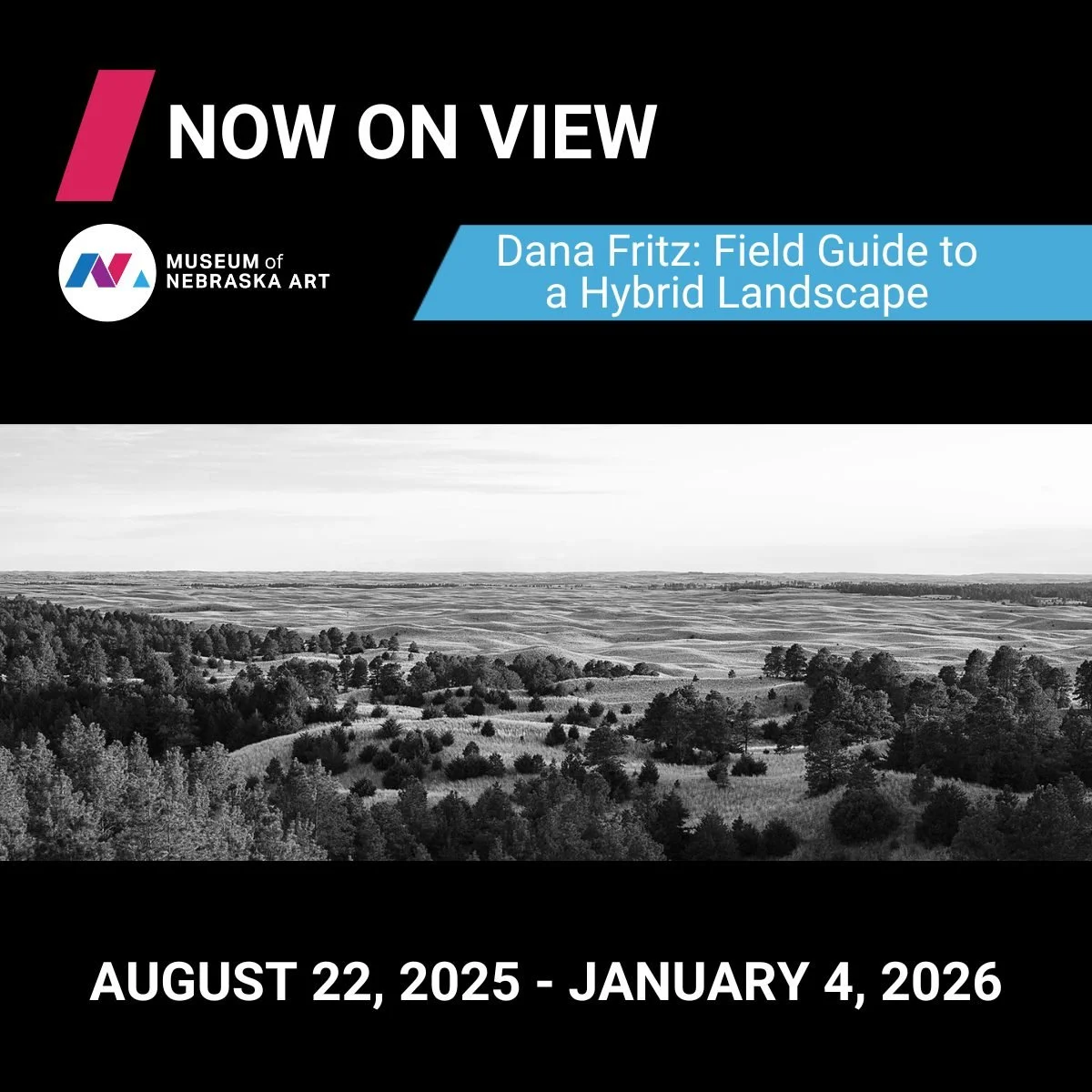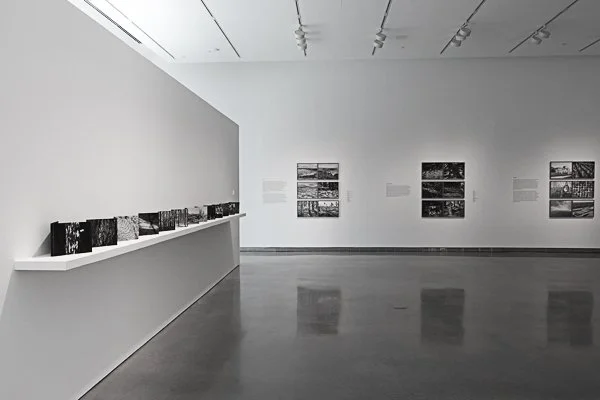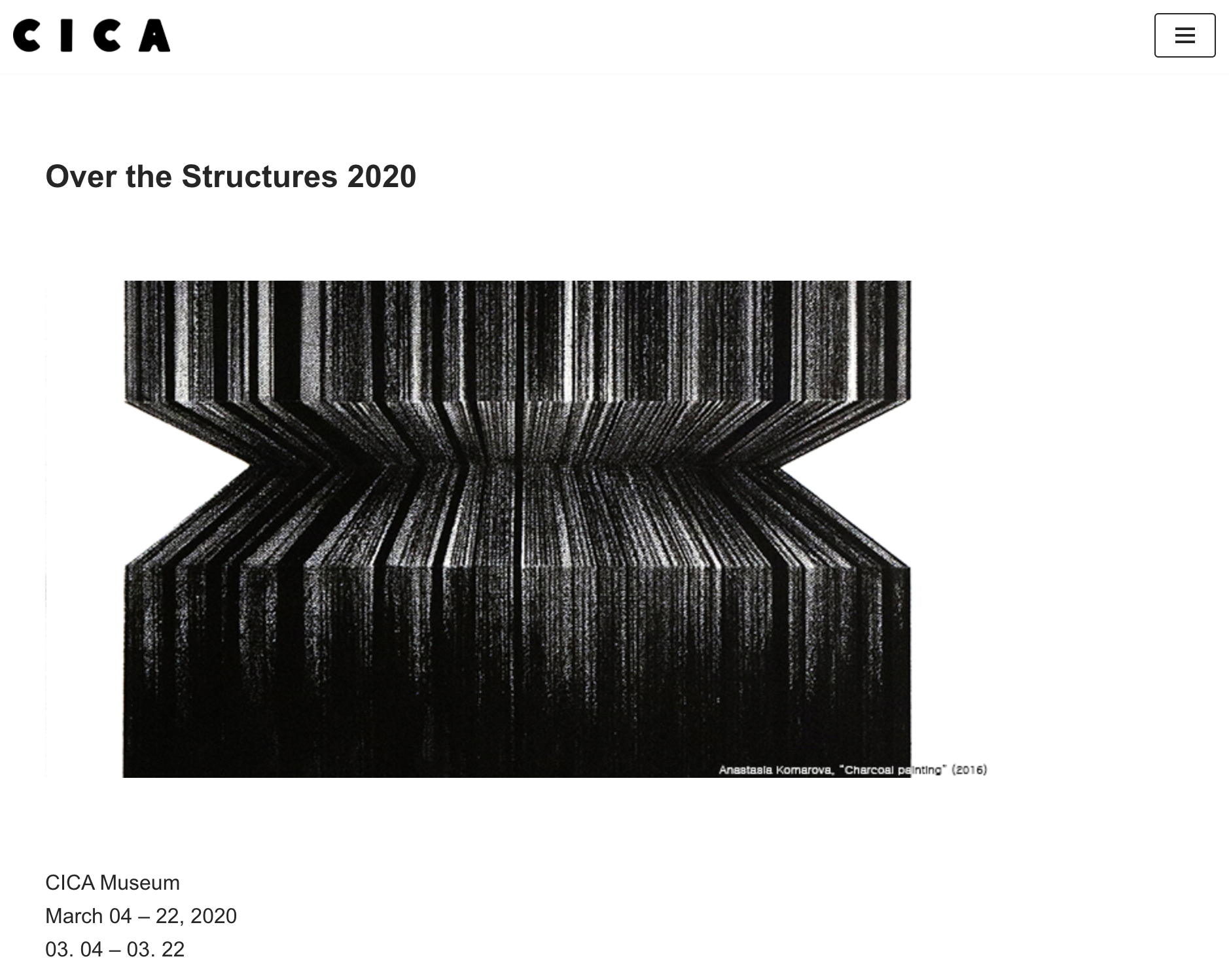
DANA FRITZ: FIELD GUIDE TO A HYBRID LANDSCAPE
Dana Fritz’s photographs reveal the forces shaping the Bessey Ranger District of the Nebraska National Forest and Grasslands. Once the world’s largest hand-planted forest, the site is known colloquially as the Nebraska National Forest at Halsey.

ARTIST TALK WITH DANA FRITZ
Hixson-Lied Professor of Art and landscape photographer Dana Fritz will guide visitors through her exhibition Dana Fritz: Field Guide to a Hybrid Landscape. This exhibition is currently on view through January 4th, 2026.
Free and open to the public.

ARTISTS TALK WATER
Join exhibiting artists during opening weekend—Jess Benjamin, Dana Fritz, Dylan AT Miner, the Platte Basin Timelapse founders, and Tali Weinberg—as they each discuss their work in From the Great Lakes to the Great Plains: The Visible Currents of Climate Change.

FROM THE GREAT LAKES TO THE GREAT PLAINS: THE VISIBLE CURRENTS OF CLIMATE CHANGE
Examining the interrelationship between past, present, and future landscapes of the Great Lakes and Great Plains regions, this exhibition highlights how water remains at the core of all climate change conversations.

Adapting our Work to a Changing Climate
This panel assembles four artists at at various career stages and from diverse geographic locations to discuss how we have adapted the subject, content, materials, and/or processes of our work to the changing climate and invites a robust discussion with the audience about how and why to adapt.

Field Guide to a Hybrid Landscape
Dana Fritz’s photographs in this exhibition make visible the forces that shaped the Nebraska National Forest and Grasslands’ Bessey Ranger District in the Sandhills. This hand-planted conifer forest was overlaid onto a semi-arid grassland in an ambitious late-19th-century experiment to create a timber industry and change the local climate. In black-and-white close shots and panoramic views, Fritz beautifully highlights the natural and human-defined patterns on the land.

Searing: Works by the Women’s Environmental Photography Collective
From the Collective “In Spring 2020, the Environmental Photography Collective was born out of a desire to create a more inclusive space in the historically androcentric fields of landscape and environmental photography. As artists with a long history as educators, our members have diverse yet overlapping interests that include environmental science, land use, biology, geology, cultural studies, and social justice. The breadth of our interests helps to build connections between cultural producers, community leaders, emerging artists, and scientific researchers, creating new production methods and ways to disseminate our work.”

Climate/Change
Climate / Change, a celebration of art, in all media, that captures the spirit and creative voices of artists living in Iowa and a 300-mile radius of Sioux City. This year’s exhibition showcases a powerful mix of emerging and established artists whose work engages with the unique cultural, social, and environmental narratives of our time.

Homeland: Photographs from the Anthropocene
The landscape photography exhibit “Homeland: Photographs from the Anthropocene” will be on view March 1-April 5 in the Brick City Gallery.
The exhibit features the works of four artists: Ian Campbell, Terra Fondriest, Dana Fritz and Drew Nikonowicz. Each artist will give a brief gallery talk April 5 from 6:30-7:30 p.m.

Nuevas topografías fotográficas: de vueltas con el paisaje
«Nuevas topografías fotográficas: de vueltas con el paisaje» es una exposición colectiva de carácter internacional integrada por el trabajo de dieciséis artistas visuales que investigan desde la plástica fotográfica la noción de paisaje. El título constituye un guiño al hito expositivo que supuso «Nuevas Topografías: Fotografías de paisajes alterados por el hombre», muestra organizada por la George Eastman House de Nueva York en 1975, donde diez fotógrafos cambiaron para siempre la forma de percibir y contemplar el paisaje como género fotográfico y pensamiento social y cultural.
![[un]Certain Futures](https://images.squarespace-cdn.com/content/v1/67be71825e97e37feb023a23/1742523611029-QBJEZ0FMZMKSW3YA01TG/NewArtsSpace+Logo.jpg)
[un]Certain Futures
Uncertain.
In these last few years, we’ve heard, read, and uttered this word repeatedly. The global pandemic, social upheaval, glaring inequality and the climate crisis. Uncertain is a word we use when we don’t know how to predict an outcome. It’s a word we use when the future feels unknowable. And because art has the capacity to hold time—the past, present, and future, often simultaneously—we turn to it for hope.

image maker talk
Friday, March 17 - 9:00AM to 9:45AM
Tower C
In Field Guide to a Hybrid Landscape Dana Fritz's photographs reveal forces that shape what was once the world's largest hand-planted forest, located in the Sandhills of Nebraska. Evolving ideas about climate change both created this grassland forest and tree nursery to reclaim "The Great American Desert" and transformed them into 21st century efforts in conservation, grassland restoration, and reforestation in native forests. Patterns of rows and waves make visible the human and non-human forces of wind, water, planting, thinning, burning, decomposition, and sowing at work in this hybrid landscape.

Field Guide to a Hybrid Landscape and Re: forest
Field Guide to a Hybrid Landscape makes visible the forces that shaped what was once the world's largest hand-planted forest located in the Sandhills region of Nebraska, the largest intact temperate grassland in the world. Re:forest focuses on seedlings grown at Bessey Nursery, located in the Bessey Ranger District of the Nebraska National Forests and Grasslands. No longer producing seedlings for the hand-planted forest as originally intended, the oldest federal nursery now provides seedlings to National Forests with catastrophic fire and beetle damage.

Reimagining Earth
Reimagining Earth
Northlight Gallery, Arizona State University
Phoenix, Arizona
September 8 - October 8, 2022

Field Guide to a Hybrid Landscape
September 2, 2022–March 11, 2023
In Field Guide to a Hybrid Landscape, Dana Fritz’s photographs make visible the forces that shaped the Bessey Ranger District of the Nebraska National Forest and Grasslands, once the world’s largest hand-planted forest. Wind, water, planting, thinning, burning, decomposing, and sowing all contribute to its environmental history. A conifer forest was overlaid onto a semi-arid grassland just west of the 100th meridian in an ambitious late nineteenth-century idea to create a timber industry, and to change the local climate.

Views Removed
The Eide/Dalrymple Gallery at Augustana University opens “Views Removed: Photographs by Dana Fritz,” which will be on view from Thursday, March 24, through Saturday, April 23. A gallery reception will take place on Friday, March 25, with a public lecture from 6:15-7 p.m. in Room 123 of the Fryxell Humanities Center and gallery talk at 7:30 p.m.


Reclamation: Artist Books about the Environment
San Francisco Center for the Book and San Francisco Public Library host Reclamation: Artists' Books on the Environment, a juried exhibition of artists' books exploring our relationship to the environment at this moment on the planet.
Environmental concerns demand increasing attention, from rising temperatures and dangerous weather events, to crises in water quality, to multiplying fires...the list goes on, echoed around the globe. Book artists create works that involve, educate, and inspire action. Book art takes many forms. Reclamation: Artists' Books on the Environment seeks to inspire and educate viewers to reflect on climate change and its impacts locally, nationally, and internationally. At the same time, the exhibition endeavors to avoid dualistic arguments common to today’s divisive political scene.

Over the Structures
Featured Artists 참여작가:
Dilara Balcı, Fiona Cashell, Absent Chronicles, Sean Deckert, Mckee Frazior, Dana Fritz, Marie Hervé, stephanie mei huang, Martyna Jastrzebska, Anastasia Komarova, Hyungsun Kim /김형선, Kyoungyoon Kim / 김경윤, Nayeon Kim /김나연, Adam Knoche, Chunghsuan Lan, KyuHyun Lee / 이규현, Irina Merkulova, David Mrugala, Brendan Moran, Tyler Morgan, Labkhand Olfatmanesh, Natalie Petrosky, Brian Rusted, Ramiro Silva-Cortes, s/n + Felnyrri, Petra Szemán, Yin Ming Wong, Sora Woo / 우소라, Jiaqi Zhang

Terraria Gigantica: The World under Glass
The photographs in the series Terraria Gigantica: The World Under Glass, frame the world’s largest enclosed landscapes as possible impossibilities: Biosphere 2’s ocean in the Arizona desert, the Henry Doorly Zoo’s desert in the Great Plains of Nebraska, and Eden Project’s tropical rain forest in notoriously gray and cool Cornwall, England. These vivaria are enclosed environments where plants are grown amidst carefully constructed representations of the natural world to entertain visiting tourists. At the same time, however, they support scientific observation and research on the plants and animals housed under these ‘natural conditions’ that require human control of temperature, humidity, irrigation, insects, and weeds to cultivate otherwise impossible environments and species. Taken together, these architectural and engineering marvels stand as working symbols of our current and complex relationship with the non-human world.

Land Use
Stephen Bulger GalleryThursday, July 26, 5-8pm
Opening Reception:Thursday, July 26, 5-8pm
Exhibition Dates:July 21 - September 8, 2018
Stephen Bulger Gallery is pleased to present "Land Use", a group exhibition of work by artists Robert Burley, Dana Fritz, Geoffrey James, and Jamey Stillings.
Much of human activity is spent either glorifying or mastering our natural surroundings. Whether nurturing a garden into harmony with a built environment, or finding a natural oasis within a large city, people's interaction with nature is constantly evolving. This exhibition combines the work of four artists whose projects each explore a particular connection with nature.

IN VIVO | the nature of nature
De getoonde foto’s in TERRARIA GIGANTICA: THE WORLD UNDER GLASS zijn gemaakt in Biosphere II. Het is een van ‘s werelds grootste indoorlandschappen waar planten groeien in zorgvuldig nagebootste ecosystemen, ter vermaak en educatie van toeristen en ter ondersteuning van wetenschappelijk onderzoek. Biosphere II is in de jaren tachtig ontworpen als een luchtdichte replica van de aarde, ten behoeve van onderzoek naar ruimtekolonisatie – Biosphere I is onze aarde zelf. Het experiment mislukte en de locatie wordt nu gebruikt voor onderzoek en educatie over duurzaamheid. Deze en andere architecturale en bouwkundige wonderen, met ecosystemen die elders onmogelijk zouden kunnen bestaan, zijn symbolen van onze complexe relatie met de natuurlijke wereld. Fritz nodigt zo de kijker uit om na te denken over onze verantwoordelijkheden en onze ecologische toekomst.

Nature, So-Called...
Nature, So-Called...
(Dana Fritz, Meike Nixdorf, and Toshio Shibata)
Bryn Mawr College, Class of 1912 Rare Book Room, Canady Library
Bryn Mawr, Pennsylvania
![[dis]functional: Products of Conceptual Design](https://images.squarespace-cdn.com/content/v1/67be71825e97e37feb023a23/1742524720319-YRQNKIA75LDLBD8TRMLM/5.jpg)


Living Together: Nurturing Nature in the Built Environment
Dana Fritz, Ellie Irons, Anne Percoco, and Tattfoo Tan
March 21 - May 13, 2016
Curated by Gallery Director Kristen Evangelista, this exhibition addresses our complex, mediated, and often fraught relationship with nature, and features plants as well as photography, drawing, and collage by Dana Fritz, Ellie Irons, Anne Percoco and Tattfoo Tan.




The Romance of the Moon: Science Fiction Invades Art
In celebration of the 150th anniversary of Jules Verne’s pioneering and prophetic novel “From the Earth to the Moon,” Sheldon Museum of Art will open an exhibition that explores the rich visual history of science fiction.
“The Romance of the Moon: Science Fiction Invades Art” opens May 1 with a reception from 5 to 7 p.m. featuring a lunarcore fashion contest, theremin music by Jared Alberico and visits to the UNL Student Observatory from 9 to 11 p.m. to view various objects including Venus, Jupiter and the moon.
Sheldon’s First Friday reception and the University of Nebraska-Lincoln Department of Physics and Astronomy’s public night at the Student Observatory are free and open to the public. Both venues are located on the UNL City Campus. Sheldon Museum of Art is at 12th and R streets, and the UNL Student Observatory is on the top floor of the parking garage at 625 Stadium Drive.
The artwork in “The Romance of the Moon” explores several themes commonly found in the genre, including space exploration, environmental crisis, the cosmic uncanny, the relationship between human and machine, close encounters and creative invention. This constellation of interests manifests itself in a variety of media through abstraction, realism, hyperbole and humor.
During the 2015-16 academic year, “The Romance of the Moon” will travel to eight venues across Nebraska as the 29th annual Sheldon Statewide exhibition.